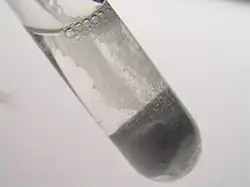Strontium nitrate
2.png) | |
 | |
| Names | |
|---|---|
| IUPAC name
Strontium nitrate
| |
| Identifiers | |
3D model (JSmol)
|
|
| ChemSpider | |
| ECHA InfoCard | 100.030.107 |
| EC Number |
|
PubChem CID
|
|
| UNII | |
CompTox Dashboard (EPA)
|
|
| |
| |
| Properties | |
| Sr(NO3)2 | |
| Molar mass |
|
| Appearance | white crystalline solid |
| Density |
|
| Melting point |
|
| Boiling point | 645 °C (1,193 °F; 918 K) decomposes |
| |
| Solubility in ammonia | soluble |
| Solubility in ethanol | slightly soluble |
| Solubility in acetone | slightly soluble |
| Solubility in nitric acid | insoluble |
| 57.2×10−6 cm3/mol | |
| Structure | |
| |
| Hazards | |
| Occupational safety and health (OHS/OSH): | |
Main hazards
|
Irritant |
| NFPA 704 (fire diamond) | |
| Flash point | Non-flammable |
| Lethal dose or concentration (LD, LC): | |
LD50 (median dose)
|
2750 mg/kg (rat, oral) |
| Safety data sheet (SDS) | [1] |
| Related compounds | |
Other anions
|
|
Other cations
|
|
Except where otherwise noted, data are given for materials in their standard state (at 25 °C [77 °F], 100 kPa).
Infobox references
| |
Strontium nitrate is an inorganic compound composed of the elements strontium, nitrogen and oxygen with the formula Sr(NO3)2. This colorless solid is used as a red colorant and oxidizer in pyrotechnics.
Preparation
Strontium nitrate is typically generated by the reaction of nitric acid with strontium carbonate.[2]
- 2 HNO3 + SrCO3 → Sr(NO3)2 + H2O + CO2

Uses
Like many other strontium salts, strontium nitrate is used to produce a rich red flame in fireworks and road flares. Its strength as an oxidizer, which eliminates the need for large amounts of an additional chlorine-containing oxidizer, makes extremely pure colors in the orange-red to red color range attainable with simple compositions.[3][4]
Strontium nitrate can aid in eliminating and lessening skin irritations. When mixed with glycolic acid, strontium nitrate reduces the sensation of skin irritation significantly better than using glycolic acid alone.[5]
Biochemistry
As a divalent ion with an ionic radius similar to that of Ca2+ (1.13 Å and 0.99 Å respectively), Sr2+ ions mimic calcium's ability to traverse calcium-selective ion channels and trigger neurotransmitter release from nerve endings. It is thus used in electrophysiology experiments.
References
- ^ Patnaik P (2003). Handbook of inorganic chemicals. New York, NY: McGraw-Hill. ISBN 0-07-049439-8.
- ^ Ward, R., Osterheld, R. K., Rosenstein, R. D. (1950). "Strontium Sulfide and Selenide Phosphors". Inorganic Syntheses. Inorganic Syntheses. Vol. 3. pp. 11–23. doi:10.1002/9780470132340.ch4. ISBN 978-0-470-13234-0.
{{cite book}}: ISBN / Date incompatibility (help) - ^ MacMillan JP, Park JW, Gerstenberg R, Wagner H, Köhler K, Wallbrecht P. ""Strontium and Strontium Compounds"". Ullmann's Encyclopedia of Industrial Chemistry. Weinheim: Wiley-VCH. doi:10.1002/14356007.a25_321. ISBN 978-3-527-30673-2.
- ^ Juknelevicius D, Mikoliunaite L, Sakirzanovas S, Kubilius R, Ramanavicius A (October 2014). "A Spectrophotometric Study of Red Pyrotechnic Flame Properties Using Three Classical Oxidizers: Ammonium Perchlorate, Potassium Perchlorate, Potassium Chlorate". Zeitschrift für anorganische und allgemeine Chemie. 640 (12–13): 2560–2565. doi:10.1002/zaac.201400299.
- ^ Zhai H, Hannon W, Hahn GS, Pelosi A, Harper RA, Maibach HI (2000). "Strontium nitrate suppresses chemically-induced sensory irritation in humans". Contact Dermatitis. 42 (2): 98–100. doi:10.1034/j.1600-0536.2000.042002098.x. PMID 10703633. S2CID 25910851.
